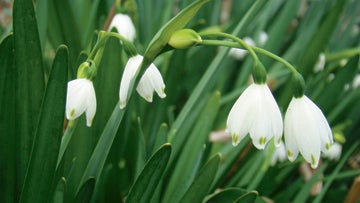Consumer Qs: snowdrop or snowflake?
Published 1:00 pm Friday, June 10, 2016

- Despite its name, summer snowflake actually blooms in spring.
Question: I want to plant our native orange butterflyweed to help the monarch butterflies. Is it possible to grow this in a pot on my patio? I do not have a yard.
Answer: Yes, butterflyweed (Asclepias tuberosa) can be grown in a pot. Choose a large one to accommodate its tuberous root. One 12 inches tall or taller will do nicely. We have had specimens growing in pots for years. It is always possible to plant something for butterflies, even if you do not have a yard and only have a small space to offer.
Q: When I visited the coast, I rescued some Spanish moss that had fallen into the street. (I did not collect it off a tree; I do not remove wild plants without permission.) Will it grow outdoors in Atlanta?
A: If Spanish moss thrived in Atlanta, the city’s trees would be covered with it because so many people have tried to grow it. The same could be said for other Piedmont cities outside the plant’s natural range. People are entranced by the strange beauty of Spanish moss and want to transform a piece of their own landscape with it.
You may have success for a few years if the weather is mild and you have a protected and humid location, but eventually your Spanish moss will go into decline and die. Yes, we know of cases where it has lived longer than a few years, but as a general rule it does not survive long-term or become established. If you have a greenhouse, it can survive in there if you keep it watered and misted.
Also, because it is prime nesting material, don’t expect the birds to leave it alone. They will gather it faster than building contractors would take free 2x4s at a lumberyard.
You are correct about removing plants. You should not take plants without permission, and municipalities may have ordinances restricting removal. While you may have been “rescuing” the Spanish moss out of the street, you are not necessarily ensuring it a long and bright future by moving it to a location where it does not naturally grow.
Q: What is the difference between a snowdrop and a snowflake?
A: Both are bulbs with pure white flowers. Snowdrops (Galanthus spp.) have three large outer petals and three short inner petals. The inner petals have green markings while the outer petals are usually pure white. Snowflakes (Leucojum spp.) have bell-shaped flowers with green dots at the tip of each petal, like a white ball-gown with emeralds sown into the hemline. There are a few flowers called snowflakes that were once classed in the genus Leucojum but have been reclassified into the genus Acis. They have white or pale pink flowers. You are unlikely to see one of them except in a botanical garden or a specialist’s garden.
Out of all of these, the one you are most likely to encounter in Georgia is the summer snowflake (Leucojum aestivum). It is durable and vigorous and will thrive in hot areas where snowdrops do not perform well. Its name is misleading, however, as it blooms in spring, not summer.
Plant bulbs for snowdrops and snowflakes in the fall. Clumps can also be dug and divided after they bloom. Replant them immediately and water them in well.
Q: I saw pots of tulips, daffodils and hyacinths for sale at a store. Shouldn’t these bulbs have been planted outside in the fall?
A: That may have been ideal, as well as cheaper, but we don’t live in an ideal world. People who were too busy or who just didn’t get around to planting bulbs in the fall can take advantage of these potted ones to brighten empty spots in their landscape. They also make nice gifts, and may be a way of introducing a non-gardener to the world of spring bulbs.
If you have questions about services or products regulated by the Georgia Department of Agriculture, write Arty Schronce (arty.schronce@agr.georgia.gov) or visit the department’s website at www.agr.georgia.gov




